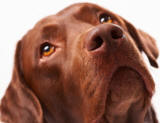
Click on
Library Icon
to learn more
|
Early
Puppy Socialization
Getting Started
Socialization is easiest with puppies because
the canine brain is pliable and wired to learn
the most from social experiences that occur
between ages 3 and 12 weeks. In adult dogs,
this can still be accomplished; it just goes
much slower. The goal of socializing a puppy is
to develop an adult dog who is comfortable and
relaxed with things encountered in the dog's
environment. A socialization checklist is a list
of specific experiences to introduce to the dog.
This intellectual stimulation increases acumen
and makes the dog "experienced." Most
importantly, it reduces the likelihood of the
dog showing signs of fearful behavior or
aggression later in life.
Baby steps
If
one of the situations on the
checklist does trigger a fearful
behavior or aggression, then it
is recommended to introduce this
situation in "baby steps." That
is, break the task down into
smaller increments, and couple
each step with praise and a
small food treat. If the fear
continues, contact an animal
behaviorist to help prevent
further development of the
fearful or aggressive response.
|
A
socialization checklist is a
list of specific experiences
to introduce to the dog.
This intellectual
stimulation increases acumen
and makes the dog
experienced instead of
socially stunted and
inflexible. |
In each case, when
you introduce the dog to the stimulus, object,
animal, or location, act happy, give a cookie (i.e.,
a food treat), and reward the dog for acting
nonchalant and without fear near the new experience.
If introduced early in life, most puppies will show
no obvious response, which is the goal. If the
socialization is not complete, the dog may suddenly
develop a phobia to one or more of these situations
later in life.
Carefully and
gradually introduce the dog to the following
checklist items:
Socialization to stimulating
objects
|
 |
Thunder/lightening |
 |
Beeping from an appliance
like a microwave |
|
 |
Traffic |
 |
Fireplace with fire |
|
 |
Mail box |
 |
Vacuum cleaner |
|
 |
Hair dryer |
 |
Wheelchair |
Socialization to other animals
|
 |
Cat(s) |
 |
Horse(s) |
|
 |
Pocket pets) (i.e., rats,
mice, hamsters, etc.) |
 |
Bird(s) |
Socialization to other locations
|
 |
Parks (including dog parks) |
 |
Other homes |
|
 |
Crowded offices |
 |
Elevators |
|
 |
Dog show |
 |
Pet friendly store |
|
 |
Dog obedience class
|
 |
Stairs |
Socialization to other people
|
 |
Mail person |
 |
Anyone wearing a hat |
|
 |
Truck delivery person such
as UPS |
 |
Rollerblades |
|
 |
Children |
 |
Skateboarder |
|
 |
Someone with facial hair |
 |
Someone with an umbrella |
|
 |
Someone with a backpack |
 |
Someone with glasses |
|
 |
Someone on a bike |
 |
Someone with a raincoat on |
|
 |
Anyone in uniform |
 |
Someone with a puffy jacket |
|
 |
A variety of people from
different ages, ethnic
backgrounds, and genders |
-
The goal is to have the dog or
puppy meet the individual on
neutral territory so that the
dog is not responding from a
territorial standpoint.
-
You can
provide a dog treat for the
other person to give your dog.
-
Once the dog responds
appropriately in a neutral
environment, continue the
meetings on and off of his or
her territory.
-
Have the new
person ask the dog to "Sit"
before giving the food treat.
-
A
useful trick is to step next to
the other person (after the dog
is sitting) so both of you are
facing the dog at the same time.
This communicates to the dog
that this person is not a threat
and that you and that person are
on the "same team." This should
reduce any aggression and make
it more likely that the dog will
accept the new person and the
cookie.
|